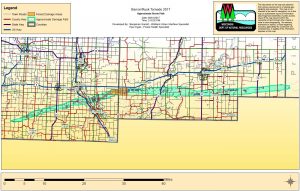
Tornado path map. Map by Paul Cigan & Benjaman Garret.
An EF3 tornado swept through northwest Wisconsin from southeast Polk County to southwest Price County on May 16, leveling many structures and whole forest stands, in what the National Weather Service has declared the longest tornado path on state record. Based on aerial damage surveys by the WI DNR Forest Health Program, the path of mapped storm damage is roughly 70 miles long, up to 2 miles wide, and covers approximately 21,000 forested acres. A notable amount of forest blowdown and broken tree stems occurred in the towns of Chetek, Grant, Grow, Prairie Lake, Strickland, Stubbs, and Sumner. Damage primarily affected private lands, including numerous MFL holdings, with limited damage mapped on the Barron County Forest. State lands were largely not impacted.

Blowndown stand, from air. Photo by Paul Cigan.
Timely salvage after the tornado can reduce insect and disease problems in damaged stands and nearby unaffected stands. Salvage helps recover any potential value from down and damaged timber. In stands where pine is present, prioritize salvage of down or tipped pine logs to avoid significant pine bark beetle infestations. This will also minimize log value losses caused by wood-discoloring, blue stain fungi. In stands where oak is present, salvage should be done with care and followed up with monitoring for oak wilt and two-lined chestnut borer to ensure more management options remain available. In all stands, priorities should be as follows:
- first priority: trees broken on the main stem exposing wood to air and moisture, trees with more than two large (>50 square inches) wounds in the lower 16′ of the tree, and trees with more than 50% of their branches destroyed
- second priority: trees with less than 50% of their branches broken or destroyed, trees that have uprooted relatively intact pulling the whole root plate with them, and trees with a few small wounds (<50 inches square).
Take the time to consider all your options and consult a professional forester for advice regarding any questions on timber sales. More resources for landowners and foresters affected by the May 16 tornado can be found on the DNR website.
Written by Paul Cigan, forest health specialist, Hayward (Paul.Cigan@Wisconsin.gov), 715-416-4920.
